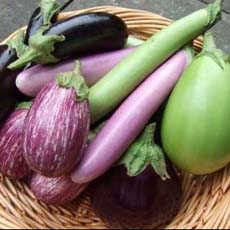TIP OF THE DAY: Beyond Avocado Toast, Middle Eastern Eggplant Toast
|
Middle Eastern eggplant toast? We’ve done classic avocado toast, we’ve done fancy avocado toast, we’ve done mushroom toast. We’ve done sweet toasts: All delicious. But the palate wants the adventure to continue. Thus, today’s toast journey is inspired by the Eggplant Toast at Kismet restaurant in Los Angeles. Here’s a variation of their spiced eggplant recipe, with different garnishes: cherries, hazelnuts and tarragon. But the photo shows a piece of artisan toast topped with: , and lim We admit to using a bit of honey, which added a sweet element to the spice-seasoned stack. OK, it takes a bit more effort than mashed avocado; but it’s worth it for a change. July is National Eggplant Month, and August 17th is National (and World) Eggplant Day. Eggplant (Solana melongena) is a member of the Solanaceae or Nightshade family: There’s more information about this fascinating family in the footnote below. Eggplant is believed to be native to India, where its ancestor, called thorn or bitter apple (Solana incanum) stills grow wild. Originally a bitter, spiny, orange, pea-sized fruit, it has been cultivated in India and China for more than 1500 years, during which it was bred into its modern forms [source]. It has been cultivated in southern and eastern Asia since prehistory, and an early mention appears in an ancient Chinese agricultural treatise from 544 [source]. As trade routes developed, eggplant was introduced to Europe by Arab ships and transported to Africa by the Persians. The Spaniards carried it with them to the New World and, by the early 1800s, both white and purple varieties could be found in American gardens. Today, the plant is grown worldwide for its edible fruit: Yes, you can tell it’s a botanical fruit because the seeds are carried inside. Although it is considered a vegetable, it is a berry by botanical definition. There are many different words for eggplant: |
|
|
|
First recorded in 1763, the word was originally applied to white cultivars, which look very much like hen’s eggs (photo #4). People the world over love eggplant: a versatile food that pairs with so many others. At some point in eggplant-loving China’s past, as part of her “bride price,” a woman had to have at least 12 eggplant recipes prior to her wedding day. Married or single, collect as many eggplant recipes as you like. ________________________ Other edible members include capsicum (the chiles), Chinese lanterns, eggplants, garden huckleberry, ground cherry, naranjilla, pepinos, peppers, potatoes, and the tree tomato. One thing that sets these nightshades apart is their alkaloid content. Alkaloids are harmful nitrogen compounds that, in high quantities, are toxic, causing nausea, diarrhea with vomiting and headaches. In extreme cases, they lead to unconsciousness and convulsions to the point of respiratory paralysis. That’s why the tomato was considered poisonous by Europeans and not eaten for 200 years following its discovery. Alkaloids exist in tiny, non-harmful quantities in the nightshade foods we eat. Tobacco and the petunia are also members of the family, as well as the Datura or Jimson weed, the mandrake and the deadly nightshade or belladonna. CHECK OUT WHAT’S HAPPENING ON OUR HOME PAGE, THENIBBLE.COM. |
||





